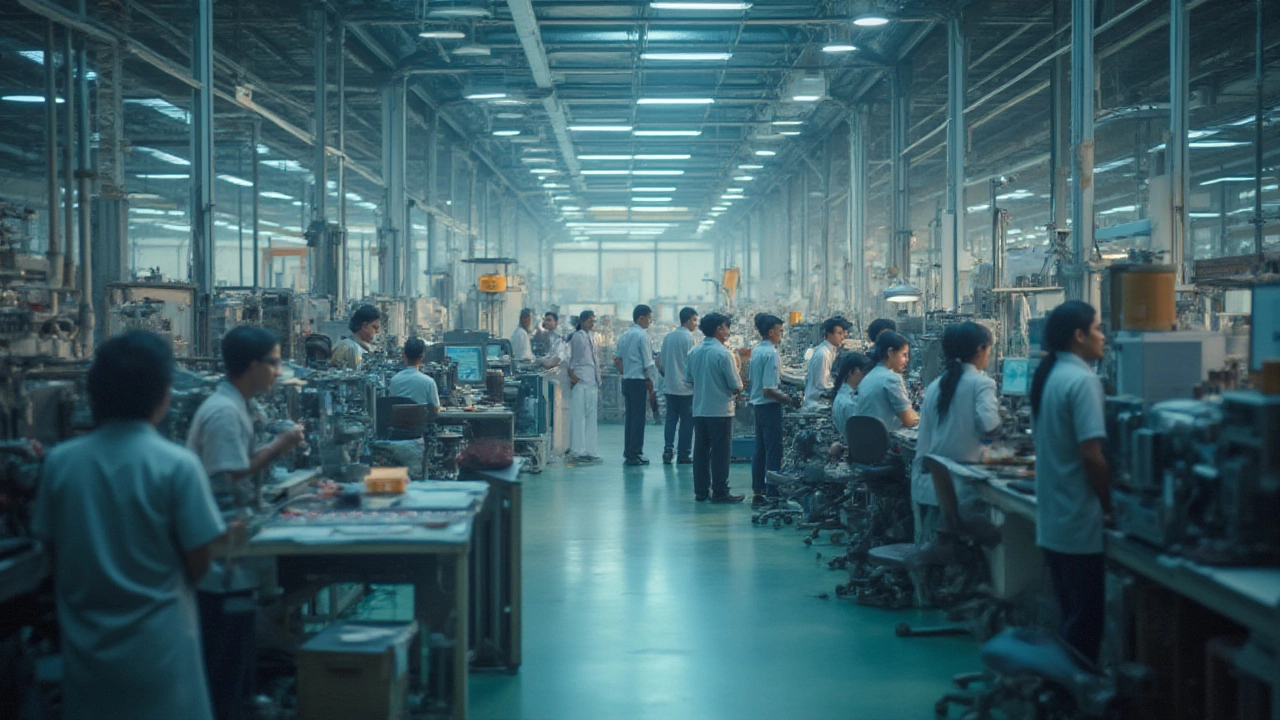If you think old-fashioned factories just churn out widgets for pennies, think again. Manufacturers today are racking up billions in profit margins, sometimes reaching 30% or higher—far above most service businesses. But which sectors are actually making the biggest bucks? Not all manufacturing is created equal, and chasing after the wrong niche can burn through savings just as fast as it spins out products. Here’s what separates the cash cows from the money pits in the world of manufacturing today.
Why Some Manufacturing Sectors Print Money—and Others Bleed It
Let’s clear up a myth: Simply opening a factory doesn’t promise fat profits. The gap between the most and least profitable manufacturing sectors is massive, sometimes bordering on shocking. Why? Three words: barriers to entry. Sectors like pharmaceuticals and specialty chemicals demand heavy R&D, regulatory approvals, and big capital, so there’s less competition—and higher profits. Compare that to garment factories or low-end electronics assembly, where anyone can enter, and you’ll find razor-thin margins fighting for every rupee or dollar.
Consider pharmaceuticals. Companies like Pfizer and Sun Pharma are not just selling pills—they’re monetizing patents, protected for up to 20 years. During that time, they can price a single treatment at thousands of dollars, thanks to lack of competition. Their gross profit margins often sail north of 60%. On the other side, look at toy or textile manufacturing, often pulled into price wars driven by retail giants or shifting trends. Margins can dip well under 10%, and a single trend miss can wipe out a season’s profits.
Location also messes with profits more than you’d think. Take automobile manufacturing: factories in India or Mexico enjoy lower labor costs and tax breaks, boosting their bottom line. But in developed economies, rising compliance and labor rates squeeze those profits. COVID-19 also redrew the map, making supply-chain resilience a big determining factor; manufacturers who weathered disruptions and could “nearshore” production have grabbed new market share that’s sticking even post-pandemic.
High profitability isn’t always about mega-industries. Niche segments—think eco-friendly packaging, medical devices, or high-precision electronics—often run with fewer players, specialized skills, and loyal customers. Take tiny Swiss watch movement manufacturing: they command prices that seem insane compared to their raw material cost, all thanks to precision, brand, and limited supply.
Regulation, of all things, can be a golden ticket. The food processing industry, for example, has tight safety standards that weed out underfunded players. If you’re in, you’re likely in for good. But those same rules mean more paperwork, higher upfront costs, and less room for error—making smart compliance systems a profit booster, not a burden.
If you’re thinking about starting or pivoting into manufacturing, remember: profit doesn’t just come from scale or efficiency. It’s about picking a lane where advantages—whether patents, technical know-how, or geographic perks—insulate you from the cutthroat hustle faced by the masses.
Which Manufacturing Sectors Have the Highest Margins?
Numbers don’t lie—and some sectors just plain win on the profit scoreboard. Let’s break down where manufacturers are actually bringing home the biggest paychecks in 2025.
- Pharmaceutical Manufacturing: The undisputed king in most markets, pharmaceutical manufacturing sees average net profit margins above 25% and gross margins often topping 60%. The main reason? Intellectual property (those unbeatable patents) and the ongoing need for medicine in every age and country. Even when generics hit the market, established brands like Johnson & Johnson or Cipla keep a loyal market that trusts their name.
- Specialty and Industrial Chemicals: While household chemicals are competitive, specialty chemicals—paints for airplanes, electronics bonding agents, medical-grade materials—enjoy loyal customers and few competitors. Gross margins regularly hit 40% or more, with big players like BASF and Gujarat Fluorochemicals leading the pack.
- Medical Devices and Equipment: Think pace-makers, imaging machines, or surgical tools. These require certification, rigorous standards, and years of expertise. Once you’re established, you can command prices several times over your production cost, and steady demand from hospitals means less market volatility.
- Food Processing: It might seem basic, but premium or branded food processing (like organic snacks, health drinks, or baby food) rides high on trust and brand loyalty. Health or trend-driven segments see gross margins above 30%, especially when exported.
- Electronics Components: Not basic assembly, but think sensors, chips, and custom circuit boards. Niche makers—especially those providing for automotive or defense—face fewer competitors, command steady contracts, and operate with gross margins of 20-35%.
- Automotive Parts (Not Assembly): The world’s cars need constant replacement parts. OEM (original equipment manufacturer) suppliers with specialized items—like precision gearboxes or high-performance batteries—often lock in automaker contracts, keeping their books healthy even when final vehicle sales slow down.
- Luxury and Precision Manufacturing: Custom jewelry, Swiss watches, aerospace-grade parts—these are low-volume, high-margin plays where quality and reputation, not cost, rule pricing. The market isn’t enormous, but for those in the game, margins can hit 40% or more.
Industries like textile, generic plastics, basic metallurgy, or low-end furniture? Often a race to the bottom. These sectors rarely see net margins above 10%, and price wars are a constant threat. They can be stepping stones or good for volume players, but the real profit magic happens higher up the value chain.

Surprise Winners: New Niches and Up-and-Coming Manufacturing Stars
If you’re tired of hearing about the same old pharma and car parts, check out these rising sectors where profit margins are shocking even industry veterans.
- Renewable Energy Equipment: The global push for green tech is ramping up profits in solar panel manufacturing, wind turbine parts, and advanced battery production. Margins on some components, like grid balancing systems or energy storage tech, can pass 30%, and the growth rate is outpacing traditional energy sectors.
- Bioplastics and Eco-Friendly Packaging: As bans on single-use plastics sweep across countries, companies making compostable materials, water-soluble films, or plant-based packaging are reporting net margins up to 20%, with prices often set by demand rather than raw material costs.
- Smart Home Devices and IoT: Not the mass-produced, basic sensors, but custom solutions for security, healthcare, or energy efficiency. Fast innovation cycles and tailored orders (think custom sensor systems for smart buildings) mean high value per unit and low-volume, high-margin production runs.
- Precision Agriculture Equipment: Manufacturers of advanced irrigation systems, AI-driven drones, or crop sensors are quietly pulling in great margins, especially when exporting to Europe, the US, or rapidly upgrading farm economies.
- Additive Manufacturing (Industrial 3D Printing): Specialized 3D printing businesses—especially those working on aerospace, medical implants, or automotive prototypes—face barely any competition. Expertise and certified quality let them charge up to 10 times the input costs.
Another sleeper hit? High-end modular furniture, both domestic and for export. Custom designs, sustainable materials, and “Made in India” exports have found a niche in Europe and the Middle East, with some manufacturers reporting profit margins on par with electronics components and food processing.
Real Numbers: How Much Can You Actually Make?
It’s tempting to get lost in ratios and projections, but what does bankable profit look like per year? Time to put some rupees and dollars behind the hype, using only legit numbers from filings, annual reports, and trusted trade data in 2025.
- Large-scale pharmaceutical factories: Big players report annual profits of $300 million to $4 billion, with small and medium companies netting anywhere from $5 to $50 million, depending on patents and scale.
- Specialty chemicals: Even mid-sized firms in this field can post profits of $10 million, while the trendsetters (think Sanmar Group in India) bring in north of $500 million from a handful of plants.
- Medical device manufacturers: From high-precision instrument makers turning out $7 million a year to giants with $1 billion in net take-home, it’s all about market reach and certification.
- Food processing: Branded, health-focused players like Nestlé India and Britannia post profits in the hundreds of millions; a local upstart with a great organic snack or ayurvedic drink can pull in $2-5 million within 3-4 years if they nail their distribution.
- Electronic components: High-end custom chipmakers serving automotive or aerospace can pocket $20-60 million per plant. Even a small firm making one kind of sensor for export can see $500,000 to $3 million net, provided their IP is strong.
- Automotive parts: Tier 1 suppliers often hit $100 million or more, with even Tier 2 and 3 outfits comfortable in the $2-10 million net range. Remember, it’s the part-makers, not the final assemblers, turning the sharpest profits per unit.
Why the variation? Intellectual property, automation level, raw material costs, and, increasingly, proximity to markets with fewer import barriers. High-value goods cost more to start, but less competition means healthier profits. Low-value goods mean constant price wars, so you’d need serious scale to turn a tidy sum.

Tips for Entering a High-Profit Manufacturing Sector
Want to jump in? Making smart moves now can carve your brand a profitable niche—even if you’re starting smaller. Here’s how the best have done it:
- Pick sectors with regulatory barriers or technical expertise. If it’s hard to enter, competitors can’t crowd you as easily.
- Protect your IP. Even in food and beverage, patented recipes or custom processes mean higher prices and loyalty.
- Automate early, but don’t skimp on quality. Profit margins stay fatter long-term if you avoid labor problems and reduce waste from day one.
- Don’t race for the bottom. Premium, branded, or customized offerings almost always win bigger margins and more loyal buyers.
- Tune your supply chains for resilience and agility. Get local sourcing or “nearshoring” right to dodge the supply disasters witnessed since COVID-19.
- Go green where you can. Both consumers and governments are slapping profit-boosting premiums on sustainable goods. Certifications like LEED or ISO 14001 can also open doors in export markets.
- Keep scouting new trends. When a niche moves—like the rise of plant-based foods or EV battery recycling—quick movers pocket the steepest rewards before everyone else jumps in.
No profit is ever guaranteed, but history—and thousands of balance sheets—show clear winners. If you focus on industries with built-in advantages, protect your innovations, and chase markets where customers value more than price, your odds of running a lucrative manufacturing business shift way in your favor.
